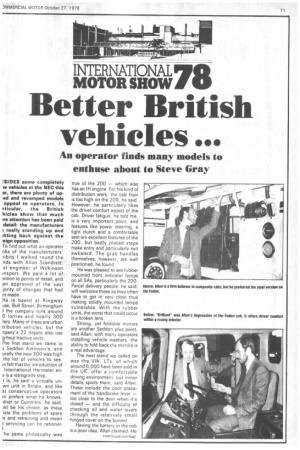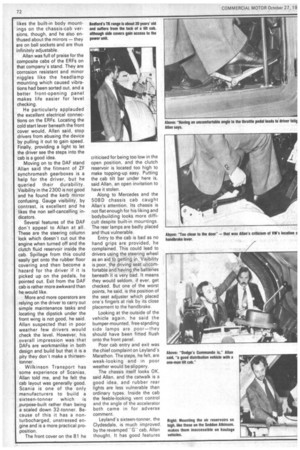INTERNATIONAL MOTOR SHOW
Page 73

Page 74

Page 75

If you've noticed an error in this article please click here to report it so we can fix it.
Better British vehicles •..
An operator finds many models to enthuse about to Steve Gray
:SIDES some completely w vehicles at the NEC this or, there are plenty of up:ed and revamped models appeal to operators. In rticular, the British hides show that much ore attention has been paid detail: the manufacturers
really standing up and ihting back against the sign opposition.
To find out what an operator nks of the manufacturers' libits I walked round the nds With Allan Scandrett ef engineer of Wilkinson insport. We paid a lot of mtion to points of detail, and an approved of the vast jority of changes that had in made.
He is based at Ringway use, Bull Street, Birmingham 1 the company runs around 0 lorries and nearly 300 lers. Many of these are urban tribution vehicles, but the npany's 22 depots also use g-haul tractive units.
Die first stand we came to 3 Seddon Atkinson's, and urally the new 300 was high the list of vehicles to see. in felt that the introduction of International Harvester ens. is a retrograde step, t is, he said a virtually unmen unit in Britain, and like St conservative operators in prefers what he knows. dner or Cummins, he said, Jld be his choice, as these iate the problems of spare ts and retraining and mean t servicing can be rational true of the 200 — which also has an IH engine. For his kind of distribution work, the cab floor is too high on the 200, he said. However, he particularly likes the driver comfort aspect of the cab. Driver fatigue, he told me, is a very important point, and features like power steering, a light clutch and a comfortable seat are excellent features of the 200, but badly placed steps make entry and particularly exit awkward. The grab handles themselves, however, are well positioned, he found.
He was pleased to see rubber mounted front indicator lamps on all SAs, particularly the 200. Parcel delivery people, he said, will welcome these as they often have to get in very close thus making solidly mounted lamps vulnerable. With the rubber units, the worst that could occur is a broken lens.
Strong, yet foldable mirrors are another Seddon plus point, said Allan; with many operators installing vehicle washers, the ability to fold back the mirrors is a real advantage.
The next stand we called on was the VW. LTs, of which around 6,000 have been sold in the UK, offer a comfortable driving environment, but minor details spoils them, said Allan. These include the poor placement of the handbrake lever — too close to the door when it's closed — and the difficulty of checking oil and water levels through the relatively small hinged cover on the bonnet.
Having the battery in the cab is a poor idea, Allan claimed. He continued overleaf likes the built-in body mountings on the chassis-cab versions, though, and he also enthused about the mirrors — they are on ball sockets and are thus infinitely adjustable.
Allan was full of praise for the composite cabs of the ERFs on that company's stand. They are corrosion resistant and minor niggles like the headlamp mounting which caused vibrations had been sorted out, and a better front-opening panel makes life easier for level checking.
He particularly applauded the excellent electrical connections on the ERFs. Locating the cold start lever beneath the front cover would, Allan said, stop drivers from abusing the device by pulling it out to gain speed. Finally, providing a light to let the driver see the steps into the cab is a good idea.
Moving on to the DAF stand Allan said the fitment of ZF synchromesh gearboxes is a help for the driver, but he queried their durability. Visibility in the 2300 is not good and he found the kerb mirror confusing. Gauge visibility, by contrast, is excellent and he likes the non self-cancelling indicators.
Several features of the DAF don't appeal to Allan at all. These are the steering column lock which doesn't cut out the engine when turned off and the clutch fluid reservoir inside the cab. Spillage from this could easily get onto the rubber floor covering and then become a hazard for the driver if it is picked up on the pedals, he pointed out. Exit from the DAF cab is rather more awkward than he would like.
More and more operators are relying on the driver to carry out simple maintenance tasks and locating the dipstick under the front wing is not good, he said. Allan suspected that in poor weather few drivers would check the level. However, his overall impression was that DAFs are workmanlike in both design and build but that it is a pity they don't make a thirteentonner.
Wilkinson Transport has some experience of Scanias, Allan told me, and he felt the cab layout was generally good. Scania is one of the only manufacturers to build a sixteen-tanner which is purpose-built rather than being a scaled down 32-tonner. Because of this it has a nonturbocharged, unstressed engine and is a more practical proposition.
The front cover on the 81 he criticised for being too low in the open position, and the clutch reservoir is located too high to make topping-up easy. Putting the cab tilt bar under here is, said Allan, an open invitation to have it stolen.
Along to Mercedes and the 508D chassis cab caught Allan's attention. Its chassis is not flat enough for his liking and bodybuilding looks more difficult despite built-in mountings. The rear lamps are badly placed and thus vulnerable.
Entry to the cab is bad as no hand grips are provided, he complained. This could lead to drivers using the steering wheel as an aid to getting in. Visibility is poor, the driving seat uncomfortable and having the batteries beneath it is very bad. It means they would seldom, if ever, get checked. But one of the worst points, he said, is the position of the seat adjuster which placed one's fingers at risk by its close placement to the handbrake.
Looking at the outside of the vehicle again, he said the bumper-mounted, free-standing side lamps are poor—they should have been fitted flush onto the front panel.
Poor cab entry and exit was the chief complaint on Leyland's Marathon. The steps, he felt, are weak-looking and in poor weather would be slippery.
The chassis itself looks OK, said Allan, and the catwalk is a good idea, and rubber rear lights are less vulnerable than ordinary types. Inside the cab the feeble-looking vent control and the angle of the accelerator both came in for adverse comment.
Leyland's sixteen-tonner, the Clydesdale, is much improved, by the revamped "G" cab, Allan thought. It has good features such as a log-book pocket and excellent driver comfort, and being a fairly low cab has good accessibility. Not so good, he thought, are the rear-view mirrors and the oil filler access. Batteries are located high on the chassis and could be difficult to check with the body on.
At the Fiat stand the 130NC was also criticised for battery access. The long exhaust to the rear is an unnecessary complication, and the absence of body-mounting points made life difficult there.
However, although the oil filler cap — under a small, flimsy panel up front — looks complicated it is designed in such a way that it would be hard to lose.
Other good points of the 130 are its water header tank Location — behind the cab — and its excellent walk-through cab, said Allan. But, as on the DAF, he said, the clutch fluid reservoir is in the cab and could suffer the same problems.
An old-fashioned idea — that's how Allan summed up the handbrake mechanism on the Fiat, but he did like the outward visibility and the electrics. Trilex wheels, too, he found not a good idea — they are not usually used in the UK.
Volvo's F7 was the next to receive the treatment and Allan said straight away it, like the F10, is too costly to buy for UK applications. By this he means that as a 16-ton rigid the F7 is well equipped for the job it has to do.
The F7 is built with components used on 32-ton vehicles, and not purpose-built. Nevertheless, he applauded the Volvo F7's cab for being comfortable and well equipped although gauge visibility is poor.
On to MAN and then Renault and Allan was glad to see the change from column to floor gearchange on the 240 MAN and Saviem. The complicated linkage is unnecessary on the former, he believed. Compartments for documents are a good MAN feature and the roller blind for the driver was also praised.
At the Dodge stand he summed up the 300-Series as better for having a flush floor in the cab, but said it is definitely a long-haul machine and one not designed for local deliveries. Visibility is good, said Allan, but details like flimsy door pulls let it down. Externally, repeater lamps are likely to be knocked off.
The Commando we looked at, in NFC colours, has a good low floor and is an ideal distribution vehicle, he said. The Coachwork Conversion body is good and so are the Henderson roller door and locking system.
Bedford's long-serving TK would have better visibility if its corner panels were not so thick, he believed. Although the cab doesn't tilt it can be removed for major maintenance to the en. gine.
.Bigger brother to the TK,. the TM, Allan thought could be dear to maintain. He pointed to the air filter, which, he said, would cost a fortune.
Access generally is good, he went on and the cab is comfort-. able and it is an ideally suited vehicle for long hauls.
Finally, we stopped at the Foden stand. Allan's obvioUs appreciation of the Foden quickly became apparent. He told me the cab on the new Fleetmaster and Haulmaster is, in his view, the best around. "Brilliant" was how he deL scribed it.
However, in spite of assurrances to the contrary Allan was a little unhappy about the composite weight-saving cab now being offered. He likes composite cabs generally as they require less maintenance.
The cab is built on a steel space frame, but Allan still felt that in this case the steel version is probably best.
Inside the instrument panel looks good, he said, and Foden's new, specially strong wiring system appealed to him.
Electrical faults are a big problem with vehicles and Allan was pleased that Fodens have made an attempt to beat the bugs.
































































































































































